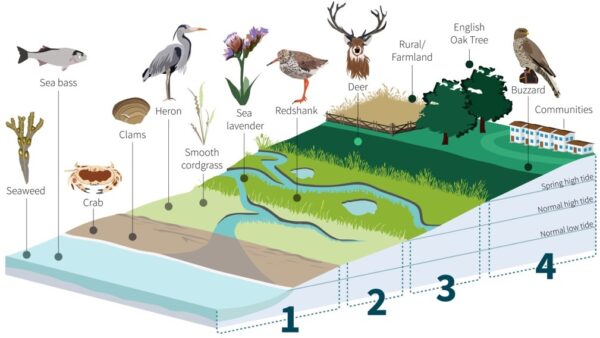The UK Centre for Ecology & Hydrology (UKCEH) has installed two flux systems in the Ribble Estuary with others to follow at Essex Marshes and The Wash in East Anglia over the coming months. The flux towers will measure how much carbon dioxide gas is captured from the atmosphere and stored as carbon within the saltmarsh ecosystem, which will provide evidence to help unlock investment in restoration schemes of these important coastal wetlands.
Native to the British Isles, saltmarshes have a significant role to play in fighting climate change by providing a long-term, natural store of carbon – known as ‘blue carbon’ when stored in coastal and marine ecosystems. Saltmarsh is also key in reversing nature loss and creating a rich and unique habitat for plants and animals specially adapted to the conditions. It is estimated that 85% of English saltmarsh has been lost in the last 200 years – primarily as a result of historic conversion to agricultural land.
Lancashire study
Research – carried out in partnership between Aviva and WWF, and in collaboration with the UKCEH and the RSPB –involves a carbon flux tower being installed on the Ribble Estuary, Lancashire. The flux tower will measure the full carbon cycle to validate the important role of saltmarsh as a long-term, natural store of carbon. It will also investigate the effect of rising sea-levels on saltmarsh habitats, helping to prioritise areas for restoration and conservation.
By live monitoring levels of carbon cycling between the landscape and the atmosphere, this data, combined with traditional methods of analysing carbon stored in saltmarsh soils, will show how much carbon is captured, how quickly, and for how long it is stored.
Figure: The structure of a saltmarsh (Source: Aviva)
UK saltmarsh loss
Some 85% of UK saltmarshes have been lost since the mid-19th century as land has been reclaimed from the sea for agriculture, development or coastal flood defences, degraded through pollution or eroded by rising sea levels. When the marsh destabilises and sediment begins to erode, greenhouse gases that are produced within the soil can be released to the atmosphere at enhanced rates.
In addition to improving biodiversity and providing natural flood protection, the plants covering the marshes draw down CO2 through photosynthesis and can also trap carbon-rich sediments in their roots and stems on the incoming tide. The UK only has about 45,000 hectares of natural saltmarsh remaining, holding a total of around 2.3 million tonnes of carbon in the top 10cm of their soil.
Further research sites
As well as the Ribble Estuary, UKCEH has installed a flux system funded by Natural England at a nearby restored site. In a separate project with the Environment Agency and Defra, UKCEH will install flux systems at sites managed by RSPB in The Wash, the Essex Wildlife Trust in Essex, and another site to be confirmed.
You can read more about these projects from the following original sources: UKCEH, Aviva, and BusinessGreen.
